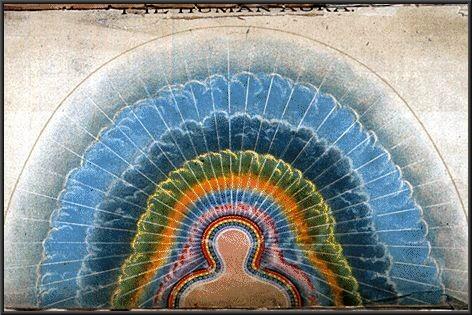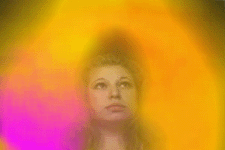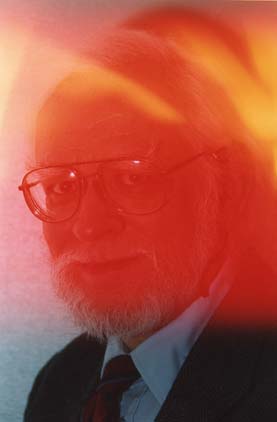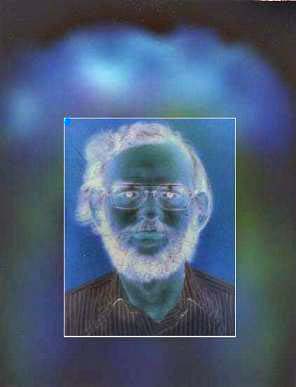
 |
It was Helena Petrovna Blavatski, the Queen of Pseudoscience, who in the late 1870s contributed the completely imaginary "human aura" to her synthetic religion of Theosophy, and it quickly percolated around within what became the 20th Century New Age movement. To its creator, the aura was a "human atmosphere... a sort of vapor or cloud... a subtle, invisible essence of fluid that emanates from human and animal bodies and even things." She and her disciples Besant and Leadbeater helpfully explained that the aura was composed of particles as much smaller than atoms as atoms were smaller than human beings... so that even individual atoms had auras. Hand-colored illustrations in Theosophy works showed the aura to have seven thin layers very close to the skin, and seven cloud-like outer layers. A card-carrying Theosophist could "intuitively sense" these layers and do various unimpressive Theosophical things with his or her "trans-sensory knowledge."
A completely invisible aura, however, is not too useful to pseudoscience, and by 1900 a number of crackpots were photographing the aura (and soul!) with ordinary film cameras, while others were viewing it using welding goggles, or spectacles of various tints, or just by squinting. Quack "medical" diagnostics with the imaginary aura became fairly common. After filtering through about 125 years worth of the head air of generations of airheads, the term "aura" has become almost completely meaningless— a New Ager babbling about the aura could be referring to the ordinary electrical sparks and streamers of Kirlian "photography," or to ultraviolet light (not emitted by humans) or infrared light (emitted by humans and everything else not at zero degrees Kelvin). But Madam Blavatski's original Technicolor, Yodachrome aura still survives, in highly mutilated and nearly unrecognizable form.
 |
 |
 |
Visit any local New Age fair and you may find a booth with what looks suspiciously like a Polaroid Land Camera, and a fat lady who for a fee will photograph your very own, personal aura. I have seen two versions of the camera. Both use a box of fiber optics which the lens looks through at the sucker..., uh, customer. In one type of camera, the optics are lit up randomly for each customer. In the other type, the customer's skin resistance is inaccurately measured and the optics display a color based arbitrarily on the resistance value. In either case the camera photographs the lit fiber optics; the customer is vaguely seen in the background, if he or she happens to sit in the right position. It is amusing to move before the photo is taken. The aura is depicted still right where the fiber optics are, with no human around. These photos are a lot more impressive when someone works them over later with Adobe Photoshop before posting them on the Internet! The photos are also a lot more impressive if the camera has an optical system sophisticated enough to possess a generic edge matte to keep the optics from "bleeding" into the area that will be occupied by the customer, so that the fiber optics colors appear "behind" the customer rather than in front. [Of course, Madam Blavatski's aura surrounded the customer and a photo of it would reveal a kind of colored manniken, not the specific customer at all. There is one, seldom-encountered version of the camera that does not show the customer at all, but always photographs a colored silhouette lit in various spots by fiber optics.] By the way, all these cameras sell for from $600 to $2000, despite the fact that some of them appear to cost about $25, including all materials and assembly.
 |

|

|
I took an aura photo of myself for just the cost of film processing, about ten cents per print. I had a colleague snap two portraits of yours truly on color print film. I then popped the back of the 35 mm camera very slightly open, exposing the two negatives to light. The result was very satisfying, as you can see. If that's not my aura, I don't know what it is!
For more on the wonders of aura photography, try here and here. For a factual discussion of the mythology, try these references: auras1 | auras2 | auras3.

In my younger days I had a very different aura, as the hypertranspiritual electronicam of those times clearly reveals. Explain this, you blind, un-American, socially-nonincluded skeptics!